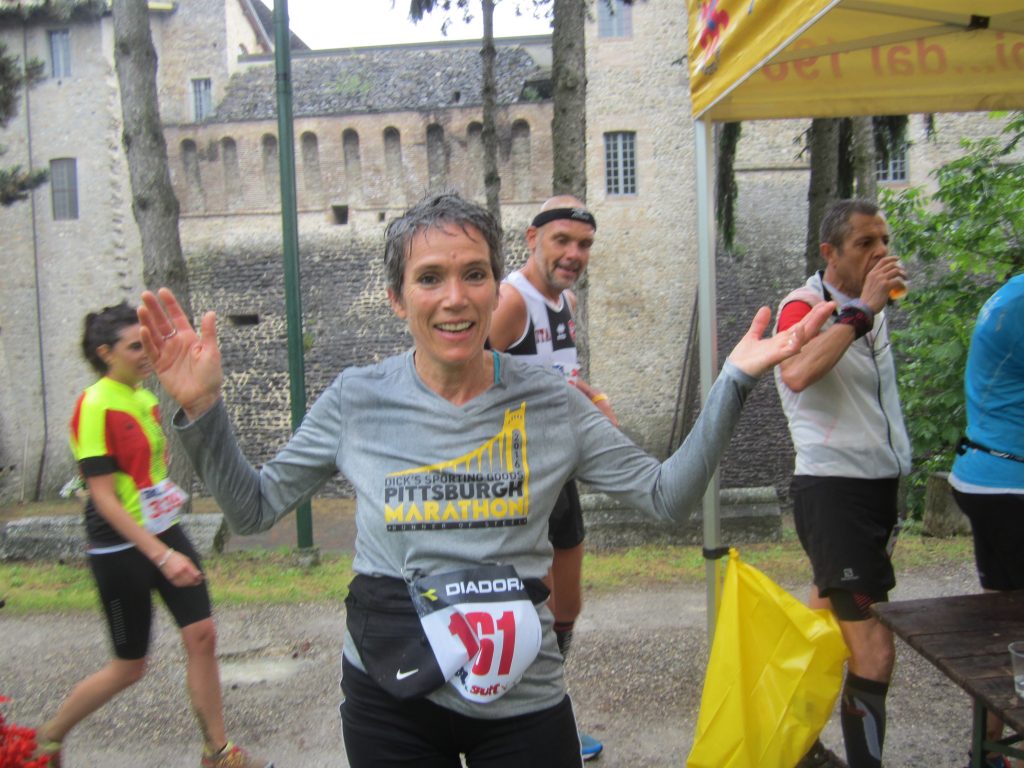
Mary Jean Bujdos in Italy. Photo credit Mary Jean Bujdos.
By Susan Brozek Scott, I Want to be an Ambassador! Director
In the last few weeks in the United States, the coronavirus pandemic has forced us to face massive challenges and disruptions to our lives at home. But for Americans traveling abroad, the stories beginning to surface now show what it has been like to try to navigate, travel home and then survive, a growing global health crisis.
Here’s just one story, a look through the lens of Western Pennsylvania’s Mary Jean Bujdos. The Springdale native, current Indiana, PA resident, and avid marathon runner (total -81 marathons), has built successful, international bridges for most of her life. She’s taught Italian studies at numerous Pittsburgh-area universities, is currently Adjunct Faculty at Seton Hill University, and is the Italian Instructor at St. Francis University.
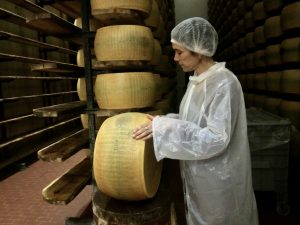
Mary Jean Bujdos in Italy
In January, Bujdos booked a reservation to fly to Italy in early March, to set up a study abroad experience for U.S. college students in Parma, while also setting aside time to handle other business and take care of property she recently bought there. At the time she made her reservation, people were talking about the rapid spread of a novel coronavirus in Wuhan, China. By February 20, a 38-year old man in Northern Italy ended up hospitalized in intensive care, and tested positive for the virus. By the time Mary Jean Bujdos was scheduled to fly to Italy, COVID-19 had begun to rapidly spread to multiple countries, including the U.S., infecting unsuspecting victims and claiming a growing number of lives.
Bujdos said two of her four adult children, who are doctors, asked her not to go on the upcoming Italy trip, but she was packed, checking travel advisories daily, and ready to go.
“I had my ticket and it was for March 2nd, and I found out my flight was cancelled to Milan, and I checked to see if it could be diverted anywhere else…to Rome,” said Bujdos. “Even though the crisis was starting to unfold, when I talked to people in Parma, which is where I go, that’s in the north, they said ‘everything is normal here, they have isolated a couple little towns, everything’s pretty much the same here, you know nothing’s closed yet.’“
On March 2, Bujdos boarded a flight from Pittsburgh to Boston, and in Boston, she put on a mask while walking on the tarmac, before boarding an Alitalia international flight, bound for Rome.
“I was sitting there and I was the only one (wearing a mask), and I started to talk to this stewardess who was Italian, and she said, ‘Look, I’m in contact with a lot of people and this virus is overblown, it’s overrated, and you know it’s a mild virus’, and the usual story of someone who plays it down, so eventually, I took it off, cause I thought, man, I’m the only person on this plane with a mask on,” Bujdos said.
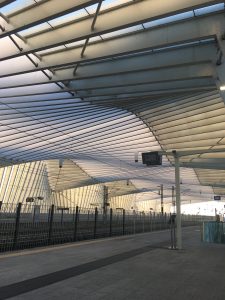
Empty train station in Reggio Emilia.
“I ended up with four seats to myself, they offered for me to move, and I was able to sleep on the plane, I just stretched out and slept. And when we got to Rome, the Rome airport was pretty empty, and the trains were kind of empty to get to the train station. And I took a train to Parma, which was also kind of empty, but when I got to Parma, my friend picked me up and we drove to Parma, everything was pretty normal. The stores were open, we walked in Downtown Parma, it was totally fine, it was really kind of normal, but everybody was talking about it, that’s all anybody was talking about, it was on the news.”
But within days of her arrival, life across all of Italy began to rapidly change. Parma was now in a coronavirus red zone. Everything that Bujdos planned to do in Parma was abruptly cancelled.
“Some of my (student) internships were going to be at the hospital,” Bujdos said, “so I had an appointment to go and talk to people in the hospital and my friend, Giuseppe, who is a nurse, said ‘you know, obviously, all of this is cancelled, and this is crazy, we are overwhelmed, we have a lot of people here, especially in the ICU.’”
Bujdos recalled, “So, there I was, with nothing to do, but clean up the wood in the yard and things like that in this little house, that’s kind of how I played out my time. I was working back and forth with people in Seton Hill, and checking on my courses online that I was teaching here and I started to hear news about that.
They knew that I was in Italy and they said when you come back, it’s been determined that you’re going to have to self-isolate for two weeks and I said, that’s ok, I guess. You’ll teach from home when you come home. Gosh, I guess it was two days later, that they decided to cancel the classes from St. Francis for a month, then Seton Hill decided to cancel their classes for at least the end of the month and then we went back and forth about our program in May, and then that was cancelled. So, everything that I went there to do just changed, within a matter of days.”
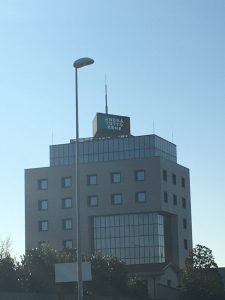
Building sign in Reggio Emilia that reads: Everything will be fine.
With life literally changing by the hour, and Italy’s number of recorded infections and coronavirus deaths soaring, Bujdos experienced three weeks ago in Italy the shutdowns, the uncertainties, the social distancing and the self-isolation that’s now sweeping across the United States.
“It is a feeling of helplessness. You feel strange in your environment because of this being so undetectable and so invisible. And the uncertainty of it puts you at a very strange place in terms of your mental state and your emotional state, because there’s such a mix of attitudes, about the whole thing. You become very individualized in your approach to it. You decide that you make a choice whether you’re going to worry, or say hey, I’m in a beautiful place and I have the opportunity to enjoy this day, instead of spending this entire day in fear. It’s always a choice. But there, that choice was harder”, said Bujdos, “I consider myself a very positive person, you know, recent decisions I made to be there part of the year, those were kind of undermined, but I still had to somehow find a place in myself where I could feel positive about making that decision to be there, then I started to realize it was a pandemic.”
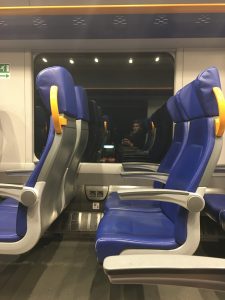
Leaving train station in Rome on March 11.
By March 9, all of Italy was placed in an emergency lockdown, as Italy’s Prime Minister Giuseppe Conte ordered people to stay inside their homes and get permission for essential travel. Two days later, on March 11 in the U.S., President Trump announced travel restrictions from Europe that would start at the end of the week, in an effort to stop the spread of the coronavirus.
As Americans scrambled to book flights back to the U.S., Mary Jean Bujdos booked a March 13th flight to return to the United States, but her airline moved the flight up a day, and she began a trip by car, and then by train, to get to the airport, showing required documents to police along the way.
“There were documents in place that everyone had to have with them in their car in case you were stopped at a checkpoint by the Italian police to state where you were going and why. You had to download this document, fill it out and have it ready to show and have a reason why you were leaving the area,” Bujdos said.
By the time she got to the train station, Bujdos said the only people there were seven police officers, standing watch.
“When I got to the airport, it was full of people from all over the place, people were sleeping on the chairs. I ended up getting a room there, they have a Hilton, they have a hotel attached to the airport, so I could just kind of isolate myself from what I might pick up, because my plane was in the morning,” Bujdos said.
“When I got up the next morning, I got in line for Delta. This was a line to check in, and the Delta employee was trying to tell people in English to keep a meter distance from each other and the American’s weren’t doing that. I don’t want to make a big point of that, but the Americans weren’t listening. It made me feel a little strange, because I was used to the meter distance.”
What stands out to Bujdos is what happened next, on and after, the two flights she took to return home to Western Pennsylvania. Her international flight was on a packed plane from Rome to Boston-Logan International Airport.
“Coming back, I was really curious about whether we would be tested. I don’t think anybody had a mask on. I think there were two or three people who had masks on in the plane; there was a child, a toddler, just walking up and down the aisle of the plane, and no mask. And, when I got back, I didn’t know what the protocol was going to be like. The flight from Rome to Boston, there was a man circulating with a document that he was giving everyone to fill out, it was a questionnaire about whether you had fever, or some symptoms, and where you had been, and then you signed it, and that was it. And they put all those documents in a box, as you got on the plane, and when we got there, everyone just walked off the plane and left. There were no tests, there was no check, no one asked me where I had been in Italy. I guess they were counting on those documents for that information. And that was it. Everyone just walked off to where they were going,” Bujdos said. “I had an eerie feeling just getting off the plane, and I was preparing myself to at least be asked a few questions about where I had been, because we were all coming from Rome. At that point in time, we knew that those flights were going to be stopped on the 13th. So, that was an opportunity lost for containment and being clear about the guidelines for when those people came back, because I seriously doubt if 300 people are in two weeks of isolation.”
Bujdos decided on her own to wear a mask the entire flight from Boston to Pittsburgh, because she was coming home from a red zone, she was sitting close to other passengers, and she had already planned to self-quarantine for 14 days upon returning home.
“I think there could have been more communication systems set up for people who had just come back. A piece of paper given to everyone on the plane, saying ‘look, you’re getting off this plane, consider two weeks of self-isolation, avoid contact with other people, stay a meter apart when you’re at the store. Distance yourself from the people in your house. Wipe down all surfaces.’”
At Pittsburgh International Airport, Bujdos landed and made her way to her own car that had been left for her there, so that no one would be put at any risk driving her home. She says she has self-isolated since her return, has had no symptoms of any kind, and while she says she called both her doctor and the Indiana County Health Department to ask about getting a COVID-19 test, with no reported symptoms, she was not able to get a coronavirus test to date. Her self-quarantine of 14 days ends on Thursday, March 26, and while it may seem as though she just completed yet another marathon, number 82, she’s taking it all, one day, one step at a time.
“I was mostly concerned about doing the right thing, following protocol, especially since everything was changing daily.”
***
 About the author: Susan Brozek-Scott (I Want to be an Ambassador! Camp Director) has a rich background of experience working with young people and the community. For much of her career, Susan was a reporter and producer for television stations in Pittsburgh and other cities. Eventually she landed at Pittsburgh’s WPXI-TV. In 2008, Susan began “Afterschool Buddy, Inc.,” a children’s multimedia programming and production corporation.
About the author: Susan Brozek-Scott (I Want to be an Ambassador! Camp Director) has a rich background of experience working with young people and the community. For much of her career, Susan was a reporter and producer for television stations in Pittsburgh and other cities. Eventually she landed at Pittsburgh’s WPXI-TV. In 2008, Susan began “Afterschool Buddy, Inc.,” a children’s multimedia programming and production corporation.

